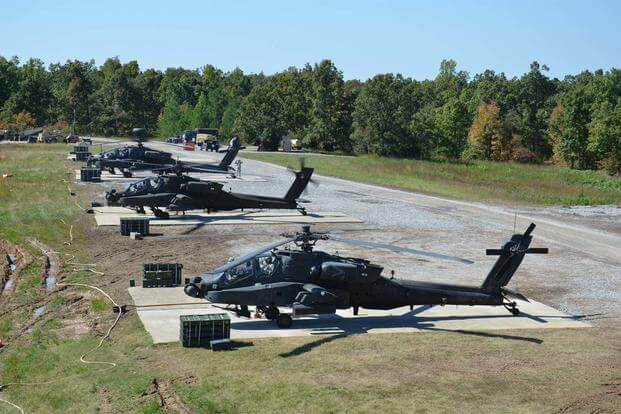One month into the American invasion of Iraq in 2003, the U.S. military conducted the longest combat air assault in history, with roughly 4,000 soldiers of the 101st Airborne Division going deep into enemy territory at night in Mosul. Three years later, the division would carry out its last brigade-size air assault in combat during Operation Swarmer, also in Iraq.
Today, many are questioning whether operations of that magnitude could be conducted after budget cuts have stripped the nation's premier air assault division of its helicopters.
Fox News traveled to Kentucky's Fort Campbell, home to the Army's 101st Airborne Division, for exclusive interviews and to see first-hand how cuts have hurt military readiness. Officials described how the storied division is painfully overstretched.
"We used to have two aviation brigades here, over 200 aircraft, and now we are down to just one aviation brigade and slightly over 100 aircraft," said Col. Craig Alia, commander of the division's combat aviation brigade and a veteran of three deployments to Iraq and Afghanistan.
Asked if he could quickly deploy and conduct a brigade-sized air assault similar to the ones in Iraq, Alia admitted, "We could not. We don't have the crews to do it."
When people think of the 101, the iconic photo of Gen. Dwight Eisenhower greeting the Screaming Eagles before they jumped into Normandy ahead of the D-Day landings, or the hit HBO series "Band of Brothers," might come to mind. The 101's military insignia is one of most recognized in the world.
But the division recently lost support when the Army disbanded the 159th Combat Aviation Brigade -- which had deployed to Iraq or Afghanistan five times since 2002 -- a victim of congressionally mandated budget cuts known as sequestration, cutting the division's helicopters roughly in half.
Alia said, Army-wide, the service is short 700 pilots, roughly the same deficit as the Air Force. Known on the radio by his call sign, "Destiny 6," Alia said the demands on their unit have not reduced, either. "So what you have is an inexperienced maintenance group that has to support a high tempo of flight hours, and it has a wear and tear on the force."
Maj. Gen. Andrew Poppas, commanding general of the 101st Airborne, said, "When you … reduce the amount of brigades that you have to deploy, yet the demand on those [brigades] goes up, you are going to have to deploy those more often. That induces stress."
President Trump has pledged to rebuild military units like the 101 and recently announced a $54 billion increase in defense spending. Some lawmakers on Capitol Hill, including from his own party, say Trump's plans don't go far enough to repair the damage.
Many officers in the division say the problems in the aviation brigade were compounded by President Barack Obama imposing strict limits on the number of U.S. forces who could deploy to Afghanistan. To meet the troop "caps," the Army was forced to leave helicopter mechanics at home, substituting civilian contractors to the tune of more than $100 million.
As a result, 1,000 Screaming Eagle mechanics were forced to stay home on its last deployment to Afghanistan, losing nearly a year of training in the process. Other aviation units also were forced to leave their soldiers behind, such as the aviation brigade from the 1st Infantry Division based at Fort Riley in Kansas.
"So this has a direct impact on Army readiness and it also costs us more money," the top U.S. commander in Afghanistan, Gen. John Nicholson, said in congressional testimony last month. He said there is currently a 2:1 ratio of contractors to soldiers in Afghanistan.
Back at Fort Campbell, while Apache gunships deployed to combat, their aircraft maintainers were stuck at home. As a result, skills atrophied, leading to frustration and morale problems in the unit -- soldiers anxious to test themselves in a war zone, according to their leaders.
"Our maintainers left back here did not have a fleet of aircraft to work on," said Lt. Col. Kenric Smith, the 101's aviation support commander.
All told, the division's mechanics lost 18 months of experience, said Smith. Adding to the readiness challenge, some of the most experienced Apache mechanics left for other jobs in the Army, he added.
Today, the division has an abundance of junior soldiers without the experience of fixing aircraft in a combat zone.
Apache maintenance at Fort Campbell that used to take 30 days now takes "twice as long," said Chief Warrant Officer 2 Robert Hodgson, an Apache pilot in the division's "Expect No Mercy" task force who deployed to Afghanistan over a year ago, after two deployments to Iraq.
The Apache is the Army's premier attack helicopter, capable of firing laser-guided Hellfire missiles, 2.75-inch unguided rockets, and a 30-mm. chain gun.
"The crews we have here are becoming fatigued," said Hodgson. "[But] they will do whatever they can to accomplish the mission."
As if things weren't challenging enough for 101's aviation brigade, Alia says he is about to lose critical experience in the cockpit.
"So what I am looking at over the next six months is a 50,000-hour loss of flight experience," when veteran pilots leave and 53 new pilots show up out of flight school, he said. The lone bright spot he says is the net increase of two pilots over current levels in the coming months, albeit pilots without much experience.
It's not only 101's aviation brigade showing signs of wear and tear.
World War II-era buildings dot the 170,000-acre Army post where the maintenance is done in old sheds with extensive water damage and dry rot.
"It really is held together with buckles and posts, but we continue to use it because it's the only facility we have," Col. Rob Salome, Fort Campbell's garrison commander, told Fox News.
Not everyone agrees that the U.S. military is suffering from a readiness crisis.
Robert Hale, a former DoD comptroller who served in the Obama administration, warned the military is exaggerating the readiness problem.
"This is a time when the services, if you will, want to put their worst foot forward and make clear all the problems that are there," Hale said in Washington last month. "So, I think we need to be a little skeptical."
Not so, says another former comptroller from the George W. Bush administration, Tina Jonas.
"I have no reasons to doubt their concerns," she said of the services.
The Army's second-highest-ranking officer raised alarm when he testified on Capitol Hill last month and said only three of the Army's 58 brigade combat teams could immediately deploy due to budget cuts.
"When we say fight tonight, that means that unit needs no additional people, no additional training, and no additional equipment. And three is where we're at today," said Gen. Daniel Allyn, the Army's vice chief of staff.
Less than two years ago, the Army announced it was cutting 40,000 soldiers. Since the election, it now says it wants 30,000 more.
Trump wants to spend $603 billion on defense, 3 percent higher than Obama's defense budget. The chairmen of the Senate and House Armed Services committees have called for spending $640 billion to address readiness problems across the services.
"While we cannot repair all of the damage done … in a single year, we can and should do more than this level of funding will allow," House Armed Services Chairman Mac Thornberry, R-Texas, said in a statement.
Jennifer Griffin currently serves as a national security correspondent for FOX News Channel . She joined FNC in October 1999 as a Jerusalem-based correspondent. You can follow her on Twitter at @JenGriffinFNC.
Lucas Tomlinson is the Pentagon and State Department producer for Fox News Channel. You can follow him on Twitter: @LucasFoxNews






























